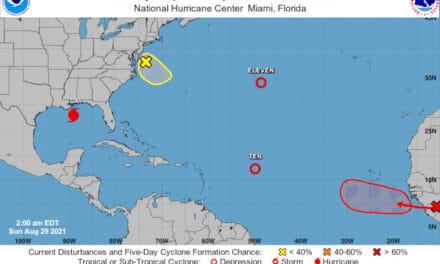November is Veterans and Military Families Month
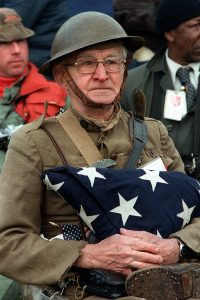
Joseph Ambrose, an 86-year-old World War I veteran, attends the dedication day parade for the Vietnam Veterans Memorial in 1982. He is holding the flag that covered the casket of his son, who was killed in the Korean War. National Archives Photo
On November 11, 1918, an armistice with Germany went into effect and thus ended World War One. WW1 was also known as the First World War, Great War, or the War to End All Wars. It started in July of 1914 and involved more than 70 million military personal. Before it ended, nine million soldiers and seven million civilians had died. Most hostilities ended on the eleventh hour of the eleventh day of the eleventh month in 1918.
The following year on November 11, 1918—the first Armistice Day—President Woodrow Wilson addressed the people of the United States to express what he felt the day meant to all Americans after soldiers and people endured four years of war. He closed by saying,
“To us in America the reflections of Armistice Day will be filled with – solemn pride in the heroism of those who died in the country’s service, and with gratitude for the victory, both because of the thing from which it has freed us and because of the opportunity it has given America to show her sympathy with peace and justice in the councils of nations.”
Full Text of President Wilson’s Address.
Congress adopted a resolution in 1926 requesting that President Calvin Coolidge declare annual proclamations for the annual Armistice Day observance on November 11. Congress approved the creation of a legal holiday in 1938. Raymond Weeks led a delegation to General Dwight Eisenhower and proposed that the holiday honor all veterans and not just those who died in World War One.
Armistice Day was renamed in 1954 to Veterans Day, but is observed in other countries as Remembrance Day and Armistice Day, also on November 11.
Memorial Day Meanings and Traditions
American Industry Pioneered Innovation

White House Portrait of President Woodrow Wilson. Portrait by Frank Graham Cootes – 1913
In his Armistice Day address, President Wilson noted that America remodeled its industry, concentrated financial resources, increased agricultural output, and assembled a great army to bring our vast resources, material, and moral to the assistance of Europe and end the conflict.
Americans have always formed a united front to face conflict. From agriculture to industry, we adapt to the needs of our country and contribute to the efforts that keep us free with contributions of man and machinery.
It’s important to remember that without the sacrifices made by our veterans, much the what we take for granted would not exist. Not only did American Veterans triumph in World War I and the wars that followed, it was the American people and their innovations and industry that supported our veterans to make success possible.
One such area of innovation was the Power Generation industry. As the country grew technologically between World War I and World War II, the need for electrical power grew with it and at the start of the second world war, electric power generators added another advantage for American troops.
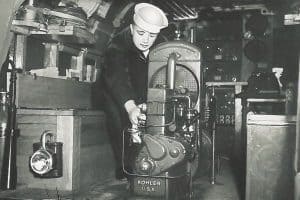
A Kohler Emergency Generator and the fast thinking of a communications officer helped save the crew of the U.S.S Borie
Kohler Company began producing an automatic generator for rural farms that lacked electrical power in the 1920s. To have electricity was a big step forward, but to produce it on demand and only when it was needed was a big technological improvement. Kohler Generators would find their way onto ships and smaller watercraft as emergency and backup generators.
After a fierce battle with a German submarine, the U.S.S Borie was badly damaged with a flooded engine room and began to sink. Only one engine was operational and at a greatly reduced speed. The ships main generators were under water and communications were impossible.
Using a combination of Zippo Lighter Fluid and Alcohol, the communications officer was able to start the Kohler emergency generator. After a distress call and the activation of an emergency beacon, the ship was located, and the crew rescued.
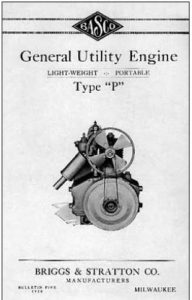
Briggs and Stratton Type P Motor Manual
Briggs and Stratton is another company whose innovations helped the American war effort. They were formed in 1908 to produce automobiles by Stephen Foster Briggs and Harold M. Stratton.
To contribute to the war effort, they began to produce electric generators. Due to the shortage of steel, some of the components included aluminum. This led to improvements over the cast-iron engines for which they were already well known. After the war, the use of aluminum contributed to their growth in the 1950s and 1960s as the lighter engines were used on new products including lawn mowers and string trimmers.
The use of aluminum benefited the war effort in several ways by freeing up steel for other uses, making lighter engines and generators, and by producing much-needed electrical power.
Both company’s generators were used throughout World War II to fill various needs and requirements for electrical power. Today, they manufacture a range of electrical generator products for home and commercial use. Both contributed to the technology and manufacturing techniques used today.
Kohler Company Briggs and Stratton Corporation
Veteran’s Day Traditions
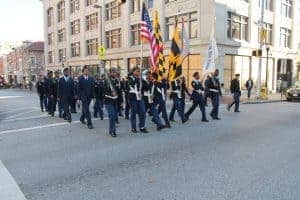
High School participation in the Baltimore Veterans Day Parade in 2016. photo by Elvert Barnes
Most countries give military veterans special treatment and recognition for the sacrifices they made and for their service. War Veterans often suffer illness such as PTSD that is related to their time of service. Others are gravely and permanently injured.
Nearly every country that was involved in World War I has an Armistice Day or Remembrance Day to honor those who served. Traditions vary from country to country and range from two minutes of silence in Africa to the wearing of red paper poppies.
In the United States, we honor our veterans with a federal holiday. Non-essential government offices and schools are closed, no mail is delivered. Schools are closed. Leaders make solemn speeches and Americans attend parades that honor our veterans. The American Legion distributes red paper poppies in exchange for small donations.
We remember Veterans and their service to our country because without them, American loses the freedoms that were fought for and won not just for us, but for everyone.
July 4 Independence Day Celebration



